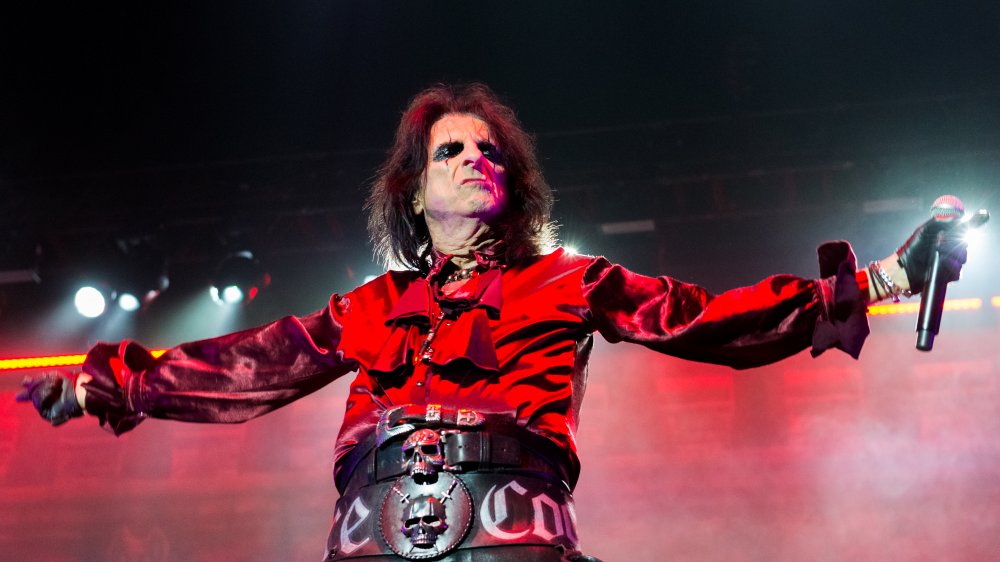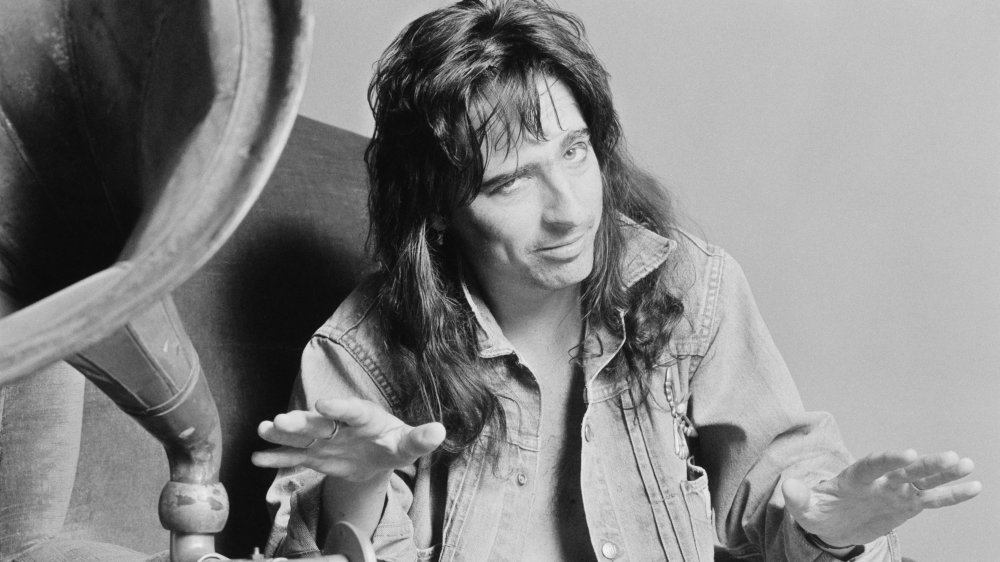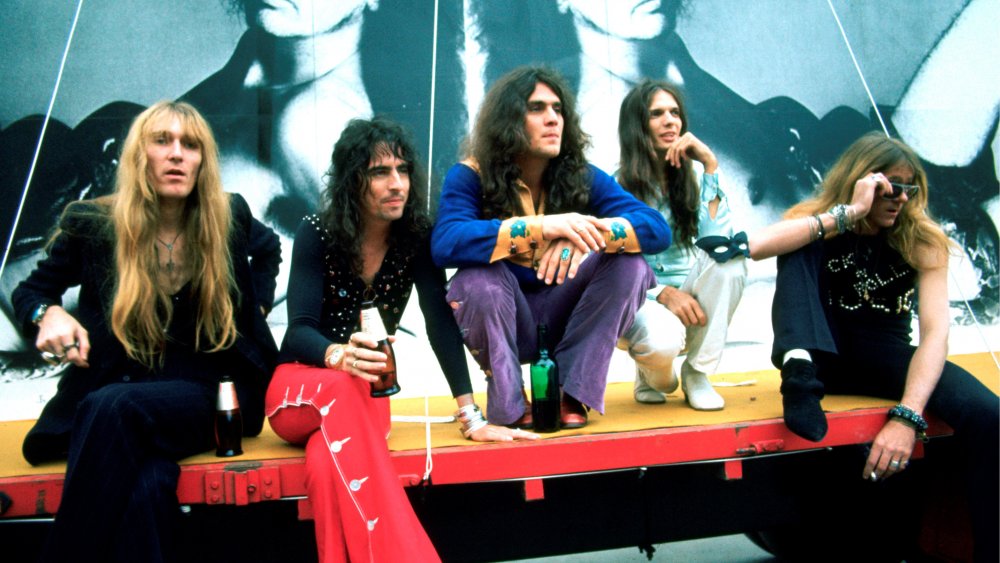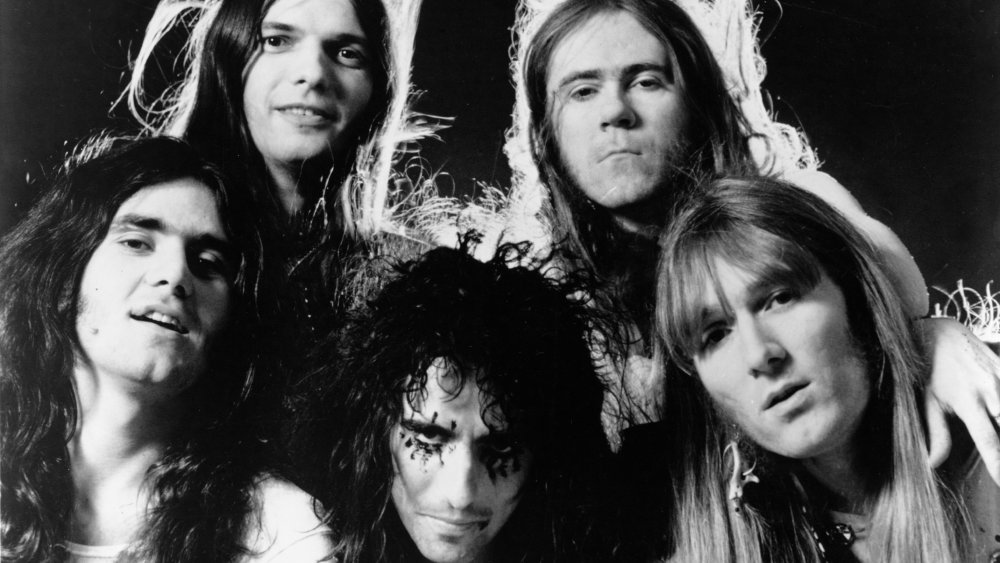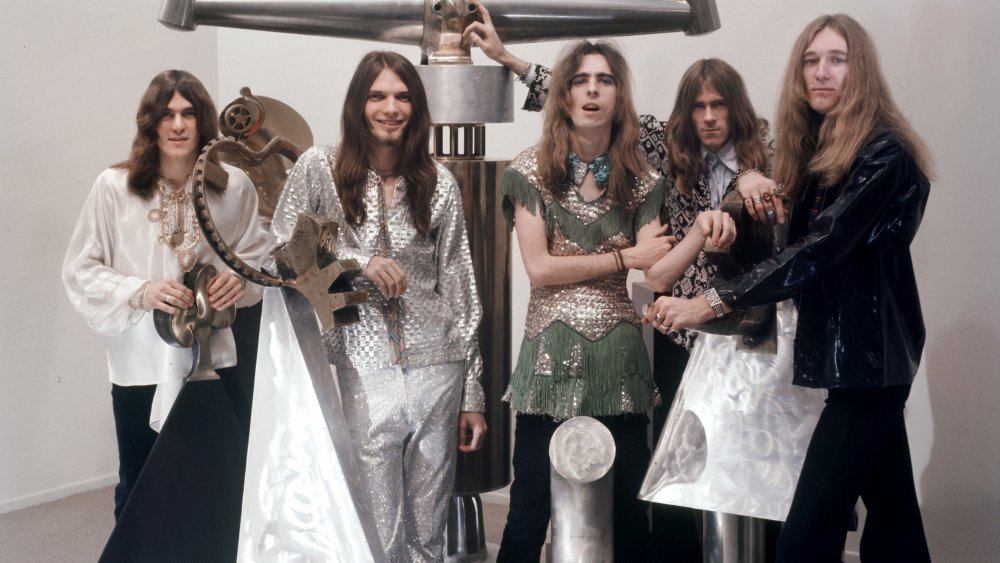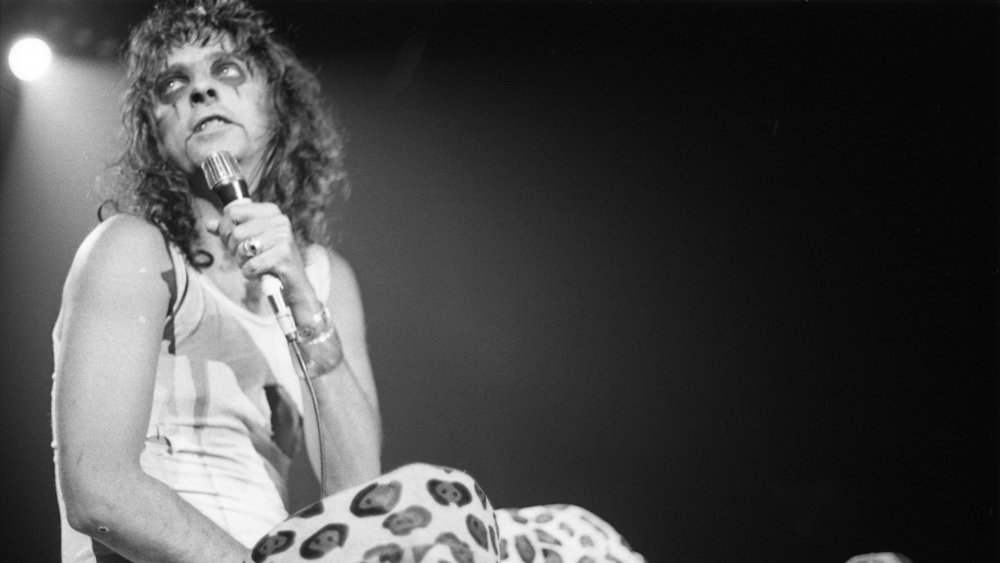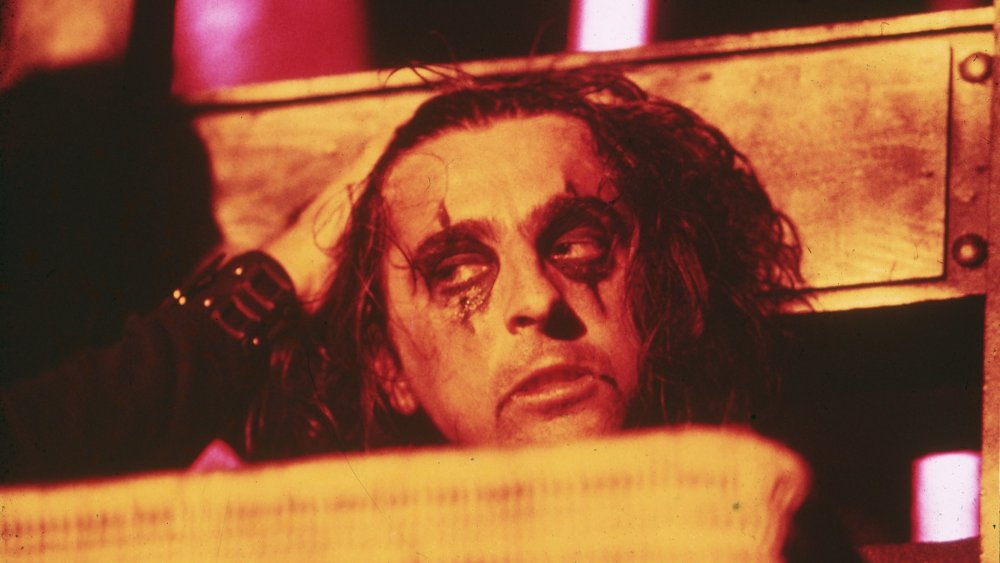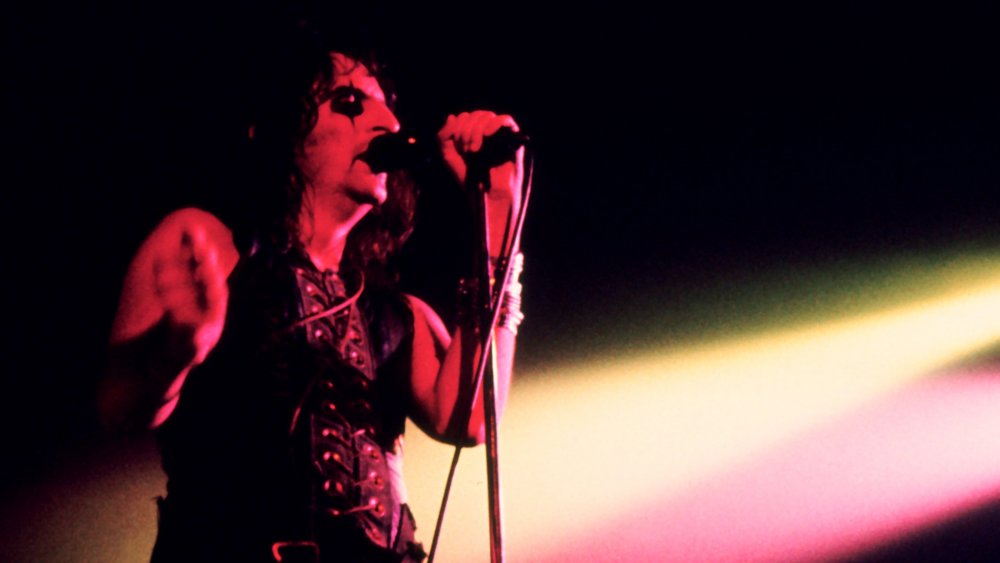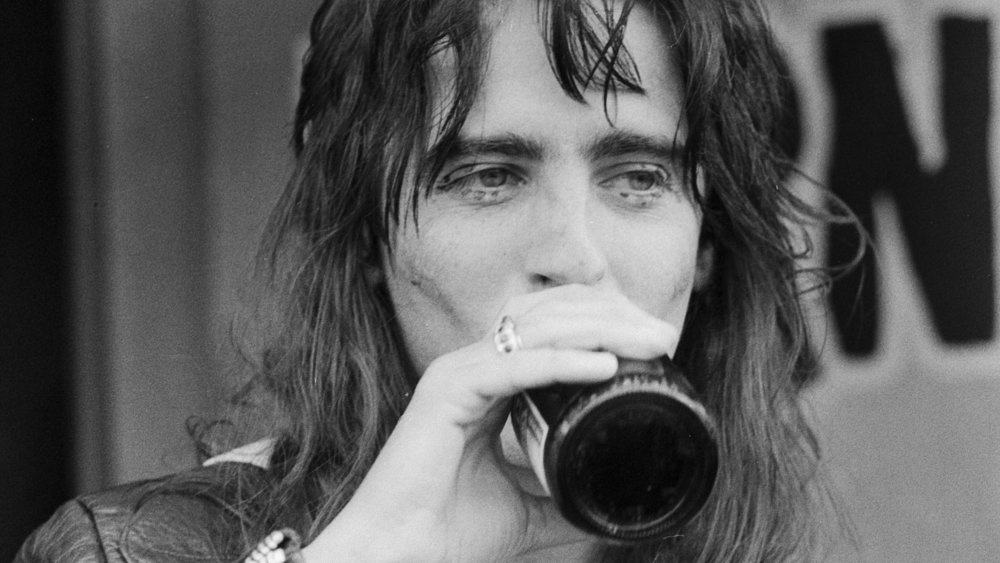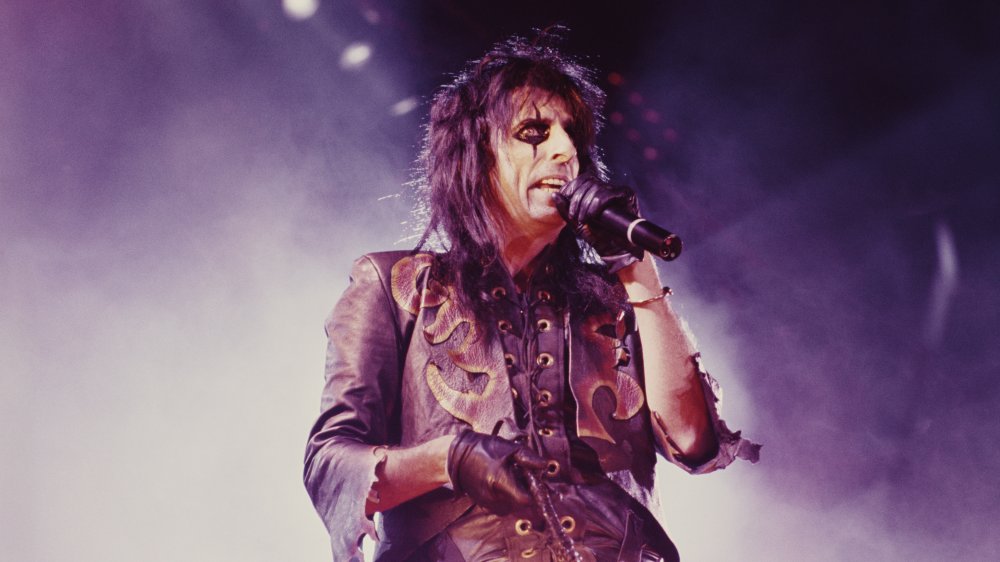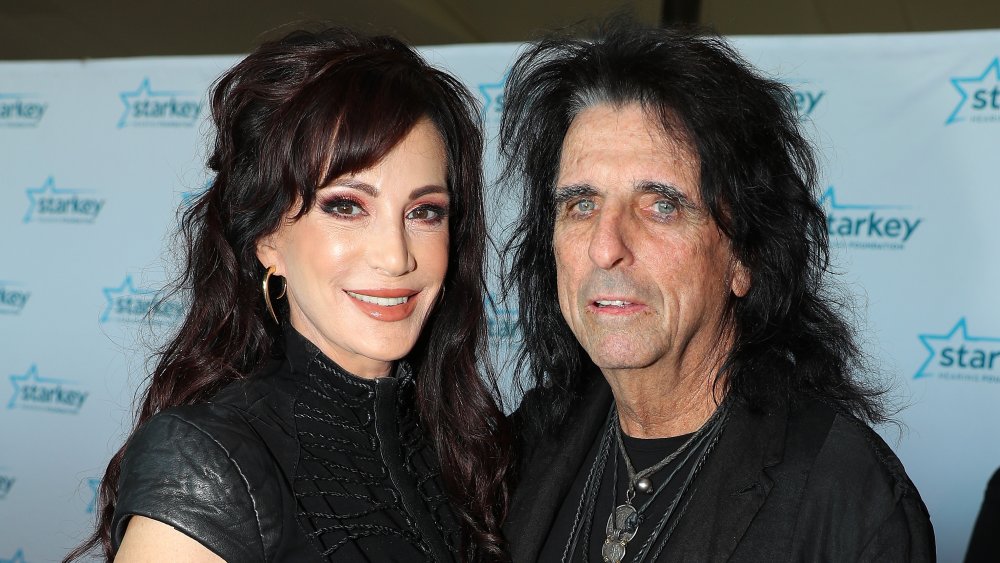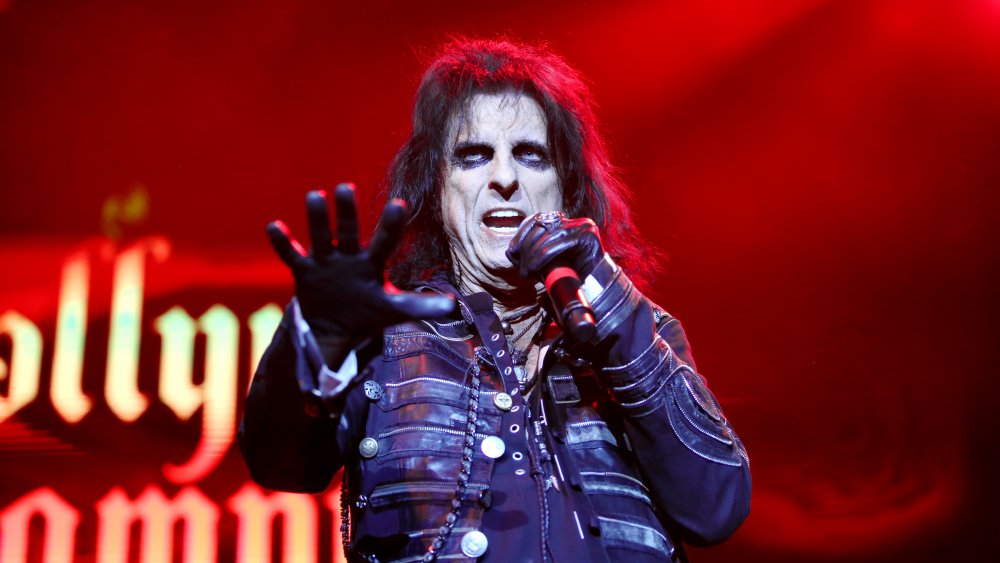The Crazy Real-Life Story Of Alice Cooper
Rising to fame in a time of musical heroes, Alice Cooper was rock's first villain. Mixing equal parts vaudeville and guignol, his bloody stage antics and outrageous persona made him beloved by kids and hated by parents. A strutting embodiment of sin and decadence in leopard boots and eyeliner, Alice Cooper was the ultimate threat to the status quo.
However, Alice Cooper, the band and the man, were much more than theatrics. In the early 1970s, they stormed the charts with fist-pumping rock anthems like "I'm Eighteen" and "School's Out." Filled with anti-authoritarian bombast, the music of Alice Cooper would prefigure the bratty rebellion of punk, the power of heavy metal, and the dark lyricism of goth.
At mid-decade, the band called it quits. The former Vince Furnier left the group and took the band's name as his own. Alice Cooper, now a solo act, was free to unleash his nightmarish vision on the world. Released in 1975, the album Welcome to My Nightmare launched Cooper to new heights. Cooper, however, was caught in a real-life nightmare of his own. As the '70s drew to an end, alcoholism and drug abuse threw the notorious singer's life into chaos. Near death, Cooper defeated his demons with faith, family, and the power of rock 'n' roll. By the end of the '80s, Alice Cooper was back on the charts and back on the road for a comeback that continues to this day. This is the crazy real-life story of Alice Cooper.
Alice Cooper, all-American boy
The man who would become the godfather of shock rock was born Vincent Damon Furnier on February 4, 1948, in America's motor city, Detroit, Michigan. The second child of Ella and Ether "Mick" Furnier, young Vince, named for his uncle and author Damon Runyon, spent his early childhood in working-class east Detroit. His father worked a variety of jobs to make ends meet, including driving a taxi and selling used cars. Cooper's mother, a transplant from Glenmary, Tennessee, and the daughter of a moonshiner, was a homemaker and waitress.
A self-described "all-American kid," Alice Cooper grew up an avid baseball fan. In his 2007 memoir, Golf Monster, Cooper writes, "I lived for baseball. When the sun came up, I grabbed my glove and I was ready to play until the sun went down, when you couldn't see the ball anymore and it was time to rush home for dinner." The only downside to Alice's happy childhood were his frequent bouts of asthma. On doctor's orders, the Furniers left Detroit for the warmer, drier climes of Los Angeles. In 1961, Mick Furnier, now a minister in the Church of Jesus Christ, took a job with Goodyear Aerospace and moved his family to Phoenix, Arizona.
Teenage Cooper attended Phoenix's Cortez High School. Gregarious and popular, Cooper thrived at Cortez. With his asthma behind him, he became a star athlete. Accomplishing the unheard-of feat of making the varsity cross country team in his first year, Cooper graduated a four-year letterman.
Along came the Spiders
The Beatles' American TV debut was a transformative experience for Vincent Furnier. Cooper writes in Golf Monster, "I came to school the day after they played The Ed Sullivan Show and it was as if a weird revolution had struck the students ... The Beatles were the ultimate catalyst for me to ... try my own hand at music."
Caught up in Beatlemania, Furnier and company decided to capitalize on the Fab Four's popularity for Cortez High's Annual Letterman's Club Variety Show. In a 1999 VH-1 interview, Alice Cooper bassist Dennis Dunaway recalls, "Alice and I said, 'Why don't we do a Beatles parody?' So, we decided we'll put on wigs so we'll be like the Beatles, only we'll call it the Earwigs." Needing some real musical muscle to pull off the gag, Furnier and Dunaway recruited guitarists Glen Buxton and John Tatum. Singing Beatles tunes with corny, track-inspired lyrics, the Earwigs were a hit, and that tiny taste of rock stardom inspired them to take music seriously. With dedication and rehearsal, they became a real band.
Changing their name to the Spiders, the band graduated to playing school dances and then small clubs. Soon, they were the stars of the Phoenix music scene. Surprisingly, one of the Spiders' biggest fans was Vince's pastor father. Although his congregation gave him flak for his son's newfound rock 'n' roll lifestyle and long hair, Mick Furnier, himself a fan of British Invasion bands like the Animals, stood by his son's musical aspirations.
Go west, young Alice
With guitarist Michael Bruce replacing John Tatum, the band recorded its first single. A psychedelic garage rock masterpiece, "Don't Blow Your Mind" was a regional hit, reaching number one on local radio's Top 40 charts. Still in high school, the Spiders were opening for some of the biggest acts of the day, including the Yardbirds, the Hollies, and the Jimi Hendrix Experience. Upon graduating from Cortez High, Vincent Furnier and his band were now faced with a life-changing choice. College or music? Collectively, they decided that the band had come too far to not take a shot at the big time, so in 1967, the Spiders left the comfortable confines of Phoenix for Los Angeles.
The band's early days in California were a far cry from their days as Phoenix's favorite rock band. By the time they reached L.A., the young musicians were flat broke. According to a 2019 Arizona Republic interview with Dennis Dunaway, the band slept on park benches and scrounged day-old food from sandwich vendors. Their luck changed, however, when they were booked as the house band for L.A.'s Cheetah Club. There, they met such rock luminaries as the Doors and Janis Joplin.
Changing their name to the Nazz, Furnier, Buxton, Bruce, and Dunaway were taking the music and their stage show in a new, avant-garde direction, much to the disappointment of drummer John Speer. Recruiting art school friend Neil Smith as his replacement, the classic Alice Cooper lineup was now in place.
Alice Cooper: a band, not a man
After discovering that their band name was already being used by Philadelphia musician Todd Rundgren for his group, Furnier and friends held a brainstorming session to come up with with a new moniker. The first suggestion, Husky Baby Sandwich, was definitely out.
For years, how the Nazz became Alice Cooper was shrouded in mystery. The most persistent legend states that Alice Cooper was the name of a 13th-century witch who had been burned at the stake. Allegedly, her spirit contacted the band during a late-night session with a Ouija Board.
According to Cooper, the band's name came about with no supernatural influence. "The first name out of my mouth was a girl's name. Alice Cooper," he writes in the autobiography Golf Monster. "By the end of the night, the name kind of stuck. ... I conjured up an image of a little girl with a lollipop in one hand and a butcher knife in the other. Lizzie Borden. Alice Cooper. They had a similar ring."
The band's mysterious new name caused quite a bit of confusion on the part of fans. People assumed frontman Vince Furnier was Alice Cooper. "I wasn't going to be Alice," he explains in an episode of VH-1's Behind the Music. "...I was Vince. When we became Alice Cooper, it was like, 'Oh, you're Alice. Hey, Alice!' and I'd go, 'Oh, me?' Pretty soon, I was Alice."
Alice Cooper hits the big time
Reinvented as Alice Cooper, the band overhauled their image to match their spooky name. With the help of L.A. girl group the GTOs, the band created a sinister, gender-bending new look. Influenced by the horror classic Whatever Happened to Baby Jane and the campy sci-fi flick Barbarella, Alice Cooper's style was heavy on makeup, leather and lingerie, per Golf Monster.
Impressed by Alice Cooper's freakshow reputation, Frank Zappa signed the band to his record label. With a record contract in hand, the band realized they needed professional management. Securing the services of Shep Gordon, Alice Cooper was finally ready to conquer the world.
Although their first two psychedelic-tinged albums, 1969's Pretties For You and Easy Action from 1970, failed to connect with critics or fans, their 1971 album Love It To Death signaled a change in both Alice Cooper's direction and their fortunes. Under the guidance of producer Bob Ezrin and manager Shep Gordon, Alice Cooper became a hard rock hit-making phenomenon. Released in November 1970, "I'm Eighteen," Love it to Death's anthemic first single was a Top 40 hit, with the album itself peaking at 35 on the Billboard charts. Alice Cooper had at last achieved their long-simmering musical dreams.
Love It To Death was no fluke — the band's next album, Killer, also released in 1971, fared even better, reaching a chart position of 21.
The end of Alice Cooper?
Alice Cooper followed Killer with their most successful effort yet with 1972's School's Out. The album's title track, a raucous tribute to high school rebellion, peaked at number seven. Alice Cooper's most popular number, the song has since become an indelible piece of pop culture. Covered by such artists as Rob Zombie and the Foo Fighters, "School's Out" captures what Cooper has called life's three best minutes – those suspenseful moments before the last school bell rings before summer vacation.
Alice Cooper's next album, 1973's Billion Dollar Babies, transcended even the success of School's Out. Their only number-one album, Billion Dollar Babies was packaged as a snakeskin wallet complete with a billion-dollar bill. Conceived as a spoof of their "overnight success," the album was the band's crowning creative and commercial achievement. The Billion Dollar Babies tour featured Alice Cooper's most elaborate show to date. A spectacle filled with snakes, blood-filled baby dolls, a rain of "billion dollar bills," and the nightly "execution" of Alice by guillotine, the tour stunned fans the world over.
Obviously, it would be hard top Billion Dollar Babies. Muscle of Love, released in 1973, was a back-to-basics rock album, according to Rolling Stone. Featuring stripped-down production and comparatively conventional arrangements, the record failed to reach the level of its predecessors. Alice and his bandmates, worn out from years of constant touring and recording, decided it was time for a break. Although it was intended as a temporary hiatus, the band's breakup proved permanent.
Welcome to My Nightmare
Although Alice Cooper the band was finished after the release of their 1974 compilation album, Alice Cooper's Greatest Hits, Alice Cooper the solo artist was just getting started.
Cooper's first solo release, 1975's Welcome to My Nightmare, is composed as a horrifying trip through the bad dreams of a little boy named Steven. Free of the constraints of a band, Cooper could further develop his rock 'n' roll villain persona as well as explore themes and musical genres outside the hard rock milieu. Along with the expected hard, driving rock sound of songs such as "Escape," "Department of Youth," and "Cold Ethyl," Cooper brought shades of Broadway and cabaret to the album's title track as well as the sardonic "Some Folks." One of the album's biggest stylistic departures is the ballad "Only Women Bleed." Touching on the topic of domestic abuse, the song reveals Cooper's underappreciated skills as both a lyricist and a singer. Rounding out Welcome to My Nightmare's horrific vibe is an appearance by Vincent Price, who gives an unhinged spoken-word performance as the sinister curator of an insect zoo.
With renewed focus, Cooper and manager Shep Gordon put up their own money to fund the Welcome to My Nightmare Tour, according to Behind the Music. A potentially disastrous move, their gamble paid off. Upping the theatricality of the show far beyond anything he'd done previously, Cooper's expensive Nightmare show featured dancers, costumes, giant props, illusions, a cyclops, and an interactive movie screen.
Alice Cooper versus the bottle
Cooper, rarely photographed without a beer in his hand throughout the '70s, had spent much of his career as a functional alcoholic. Cooper's wife Sheryl speaks frankly about her husband's struggle in a VH-1 interview conducted in 1999. "There didn't seem to be an obvious problem," she says. "If he were falling down or abusive ... I think attention would have been paid much more quickly." Concurring with his wife, Alice Cooper says, "I denied it for an awful long time ... I wasn't a cruel drunk. I wasn't a stupid drunk. I was just a drinker."
However, by 1977, Cooper's drinking was obviously affecting his performances and, more importantly, his health. Committed to a mental health facility, Cooper got clean and sober but soon relapsed. According to Cooper's book Golf Monster, the rocker doesn't remember recording his early '80s records Flush the Fashion, Special Forces, Zipper Catches Skin, or DaDa because he was in a continuous alcoholic fog.
Malnourished and near death, Cooper checked into a hospital in September 1983. Struggling back from the brink, Cooper's recovery from alcoholism was nothing short of a miracle. "When I left [the hospital], I felt strange," Cooper writes, "like I had never been an alcoholic, and more important, like I would never be one again. Something had happened inside of me."
Alice Cooper, back from the brink
After battling his way back from alcoholism in 1983, Alice Cooper spent the next three years reconnecting with his wife and children, getting healthy, and getting back in touch with his Christian faith. During this period of recovery, returning to the stage and again assuming the role of his sinister alter ego were definitely low on his list of priorities. In fact, the prospects of a comeback were downright scary to the veteran shock rocker. "The thought of going back up onstage and doing Alice without being anesthetized was pretty frightening," Cooper tells VH-1.
Nevertheless, as detailed by Golf Monster, the nightmare returned in 1986 with the release of Alice Cooper's ninth solo album, Constrictor. A typically flashy '80s heavy metal affair, the record put Cooper back on the musical map. Energized and sober, Cooper also mounted his first tour in years. Donning his famous black leather and makeup, Alice Cooper once again ruled the stage as rock's dark prince.
Cooper's 1980s return couldn't have come at a better time. With the mainstream popularity of heavy metal and glam at an all-time high, Cooper was definitely back in his element. Even the most critical cynics were forced to acknowledge his comeback when his 1989 single "Poison" from the album Trash cracked the Billboard Top 10.
Alice Cooper is a golf maniac
Along with his faith, Alice Cooper credits his love of golf as the key to conquering his demons. Cooper began playing the sport in 1973 at the behest of friend and roadie Joe Gannon. A natural at the game, Cooper was soon hooked.
Although he'd played the game for a decade, Alice Cooper truly dedicated himself to golf in 1983. As part of his recovery from alcoholism, he decided to seriously study the game and master its intricacies. Spending virtually every day on the golf course playing, on average, 36 holes, Cooper was in the throes of an all-new addiction.
Cooper doesn't use the word "addiction" lightly when it comes to golf. In 2007, Cooper told Contactmusic.com that it was no surprise that he and fellow rock 'n' roll survivors got hooked on golf. "Every guy I know from Lou Reed to Bob Dylan to Neil Young, they all play golf," Cooper says. "It's because they were all drug users or alcoholics, and I think golf is so addictive that it's just like taking drugs."
Alice Cooper is no slouch at the game, either. With a 5.3 handicap, he's a serious Pro Am competitor. Having played alongside PGA greats Arnold Palmer and Vijay Singh, Cooper states that one of the greatest compliments he's ever received was from golf legend Tiger Woods, who said he wouldn't give the rocker "two (handicap strokes) a side."
Alice Cooper, family man
More than music or golf, the center of Alice Cooper's life is his family. Married for over 40 years, Cooper met Sheryl Godard when she joined the Welcome To My Nightmare tour as a dancer in 1975, per Behind the Music. Save for a brief period during the worst of Alice's alcoholism in the early '80s, the Coopers have been inseparable ever since. The rare successful showbiz marriage, the Coopers credit their faith and keeping romance alive as the secrets to marital longevity.
Alice Cooper has three adult children: eldest daughter Calico, a dancer, actress, and singer who replaced her mother in Alice's act for a number of years and now fronts her own hard rock band Beasto Blanco, musician son Dash, who fronts the band CO-OP, and youngest daughter Sonora Rose, who works as a professional makeup artist. Cooper likes to keep his family close at hand and brings them on tour whenever possible.
Alice Cooper is a rock 'n' roll survivor
Now in his seventies, Alice Cooper is the ultimate rock 'n' roll survivor. Still touring and recording, the king of shock rock has no plans of slowing down anytime soon. In 2011, Alice Cooper and the surviving members of his legendary original band received a long overdue honor when they were inducted into the Rock & Roll Hall of Fame.
In addition to his solo career, Cooper teamed with actor Johnny Depp and Aerosmith guitarist Joe Perry to create the supergroup the Hollywood Vampires. Named for the '70s drinking club that included Cooper, Keith Moon, Harry Nilsson, and Mickey Dolenz, the band celebrates the music of rock stars who died before their time.
Once cited as a corrupting influence on youth, Cooper now inspires at risk kids through Alice Cooper's Solid Rock. Dedicated to instilling purpose in the lives of young people through the arts, the nonprofit organization opened its first teen center in 2012.
